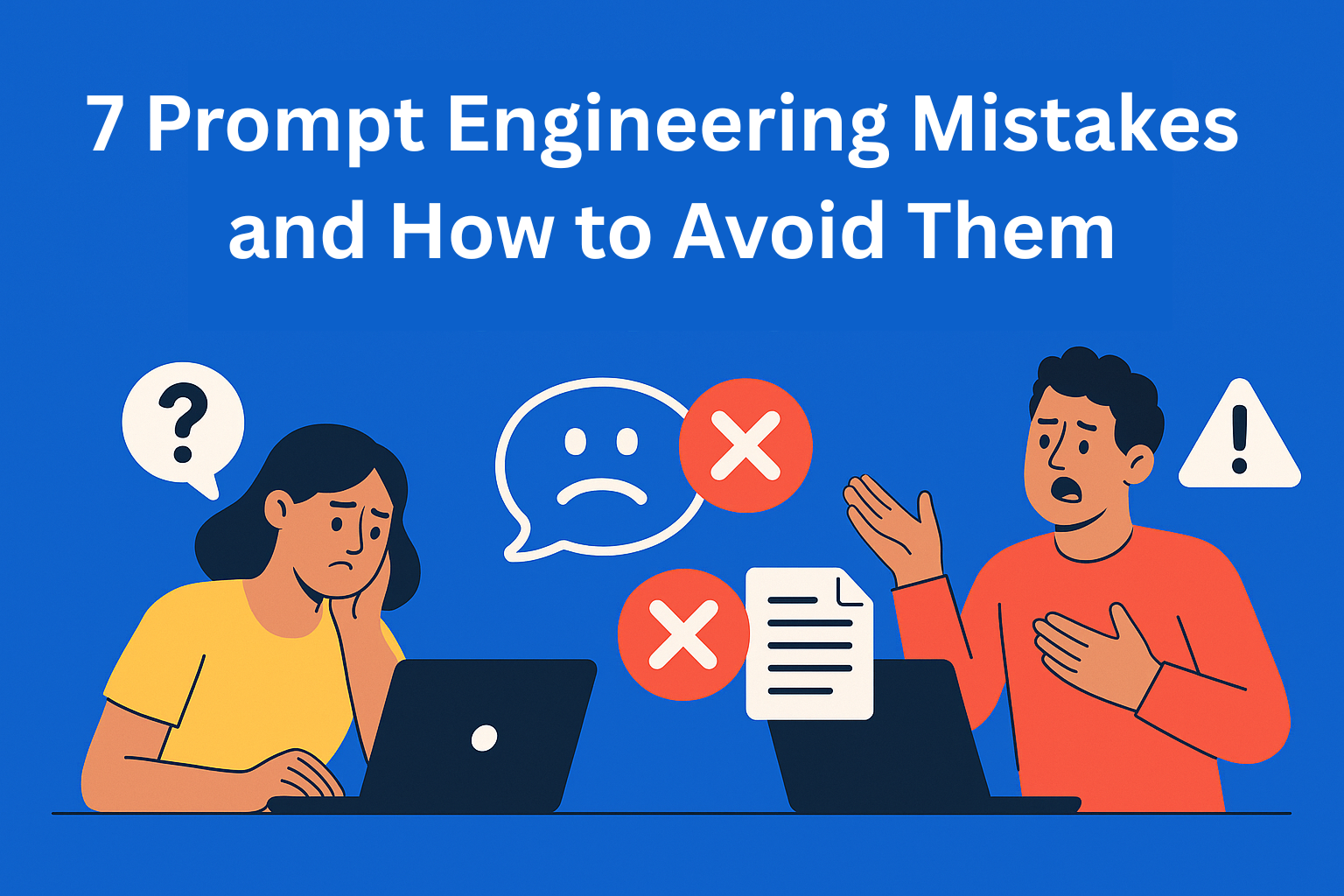7 Common Prompt Engineering Mistakes and How to Avoid Them
Avoid common prompt engineering mistakes with ChatGPT. Learn how to write clear, ethical, and effective prompts that deliver accurate and useful answers. Simple tips anyone can apply for better conversations with AI.

Using tools like ChatGPT can be very helpful and fun, but sometimes the answers don’t come out the way we expect. The reason is often simple: the way we write our questions or tasks, i.e., prompts. Prompt engineering means creating clear and effective instructions for ChatGPT so it can give us useful and accurate answers.
When prompts are poorly written, results can seem confusing, shallow, or completely off-topic. The good news is that these mistakes can easily be avoided once we know what to watch out for. In this blog, we’ll go through 7 common mistakes in prompt engineering and explain how to avoid them. By the end, you’ll know how to write better prompts and get the most out of ChatGPT.
Key Takeaways
- Avoid vague prompts - Be specific and give clear direction to get relevant, high-quality answers.
- Don’t overload your prompt - Break large tasks into smaller steps for more focused and complete responses.
- Always provide context - Remind ChatGPT of key details, especially in multi-step conversations.
- Specify the desired format - Lists, tables, or bullet points make responses easier to read and apply.
- Use role-based instructions - Assigning a role improves tone, structure, and answer depth.
- Refine through iteration - Adjust and follow up on responses to guide the AI toward better results.
- Write ethically responsible prompts - Avoid biased or unsafe instructions; focus on fairness and respect.
1. Too vague requests
One of the most common mistakes is when a prompt is formulated too generally. Without details, the answer will be superficial and generic.
Example:
- Weak prompt: “Write a text about marketing.”
- Better prompt: “Write a LinkedIn post about the advantages of content marketing for B2B SaaS companies, with a focus on long-term ROI.”
In the second example it is immediately clear which platform, which audience, and which angle are required, so the result is much more useful.
2. Too much information at once
The opposite extreme is when we cram too many requests into a single prompt.
Example:
- Overloaded prompt: “Write me a content marketing strategy, come up with 10 blog titles, write one full blog, and make a three-month calendar.”
- Better approach: “First create a content marketing strategy for a brand that sells online courses. Once that’s done, we’ll move on to blog post ideas.”
Breaking the task down helps ChatGPT stay focused and prevents chaotic answers.
3. Ignoring context
If you don’t remind ChatGPT of the context, it can lose track of the conversation.
Example:
- Without context: “What post should we publish next week?”
- With context: “We already planned three blogs about SEO trends. What post should we suggest for Instagram next week to connect the content with those blogs?”
A short reminder maintains continuity and provides more relevant ideas.
4. Forgetting the answer format
Format is crucial for making the answer practical.
Example:
- Unclear prompt: “How do we develop a content marketing strategy?”
- Clear format: “Show me a content marketing strategy in a table with the columns: content type, target audience, distribution channel, goal.”
When you ask for a list, table, or step-by-step breakdown, the output is clearer and easier to use.
5. Not using roles
Adding a role changes the quality of the answer significantly.
Example:
- Without a role: “Suggest blog ideas.”
- With a role: “Imagine you are a content marketing manager at an IT company that sells software for small businesses. Suggest 5 blog topics that would help generate leads.”
A role helps align the tone and perspective with real needs.
6. Not refining and adjusting
Rarely is the first answer perfect. Adjusting and specifying further is key.
Example:
- First prompt: “Write a blog about email marketing.”
- Further refinement: “Focus on how small businesses can automate newsletter campaigns on a minimal budget.”
- Even more specific: “Write the text in the form of a guide with practical examples and tools that SMBs can use.”
Each step brings the answer closer to exactly what you need.
7. Ignoring ethics
Even in content marketing, ethics matter - to ensure content is fair, honest, and non-manipulative.
Example:
- Risky prompt: “Write a blog that convinces people to buy by using fear of missing out.”
- Ethical prompt: “Write a blog that highlights the value and practical benefits of our product for users.”
This way you build trust and a long-term healthy relationship with your audience.
Conclusion
Working effectively with ChatGPT doesn’t require you to be a technical expert - it’s enough to know how to ask the right questions. If you avoid these 7 mistakes, your prompts will deliver much clearer, more useful, and more actionable results, especially in the field of content marketing.






